Many European breeders are developing new varieties of potatoes with coloured flesh. The vibrant hues of the flesh and skin are the result of natural pigments. The main advantage of coloured potatoes is their classification as a dietary product.
However, not all gardeners are keen to experiment and may hesitate to plant new crops. Let’s take a closer look at the features of coloured potatoes, how they differ from traditional varieties, and whether they are worth growing.
Table of contents
Description of the Crop
Coloured potatoes come in a variety of flesh tones. This is due to the presence of pigments responsible for their unique hues. These pigments have nothing to do with GMOs; moreover, coloured potatoes offer numerous health benefits.
Note. The brighter the potato’s flesh, the higher its anthocyanin content, which is beneficial for human health.
Coloured potatoes are rich in antioxidants. Some red varieties have a subtle ginger-like flavour, while purple varieties often boast a more intense, nutty taste.
The most intensely coloured varieties are used to produce natural food colouring.
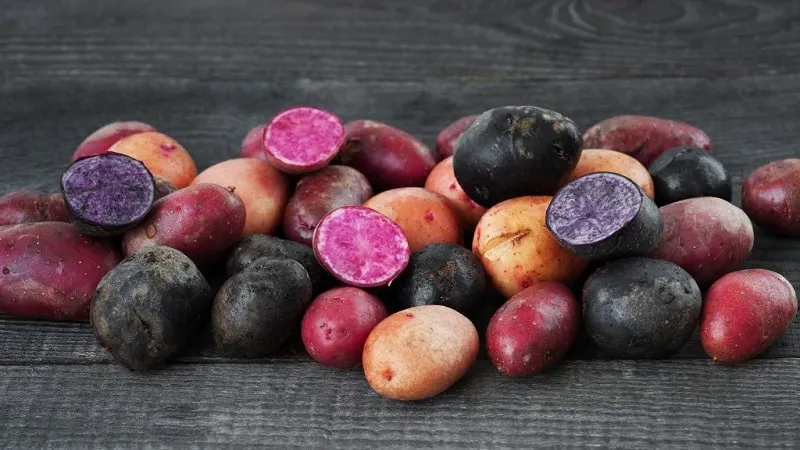
Origin and Development
Coloured potatoes have been known for centuries. Before the 20th century, European breeders like the renowned French agronomist Louis de Vilmorin offered tubers with blue and red flesh. European scientists began cultivating such potatoes in the early 2000s. Today, over 10 research groups across Europe are working on developing new varieties.
Varieties of Coloured Potatoes
Breeders have developed many coloured potato varieties. The most striking examples:
- All Blue – a mid-to-late-season variety. The tubers have blue skin and vibrant purple flesh. To preserve the colour, avoid overcooking. This variety is known for its excellent taste.
- Boro – a mid-season variety with bronze-toned skin and blue flesh.
- Explosion – an early-maturing, high-yielding variety with blue flesh.
- All Red lives up to its name, featuring delicate red skin and flesh with a nutty flavour.
- Cranberry Red – a mid-early variety with deep red skin and pinkish-red flesh. It retains its colour when boiled and has an aromatic taste.
- Vitelotte – a late-season variety with near-black skin and purple flesh, offering a sweet, nutty flavour.
- Lilac – a mid-season variety with purple flesh.
- Raspberry – a red-fleshed variety with a pleasant taste that holds its colour when cooked.
- Baroness Pink – an early variety with rounded, irregular tubers.
- Baron – an early variety with yellow skin, reddish eyes, and light cream flesh.
What Determines the Flesh Colour?
Coloured potatoes contain plant glycosides – anthocyanins. These natural pigments are found in certain plants’ flowers, stems, leaves, roots, fruits, and seeds, such as blueberries, cranberries, blackcurrants, and dark grapes.
Tip! To preserve the colour when boiling, cook coloured potatoes in their skins.
Chemical Composition, Micronutrients, and Vitamins
Coloured potatoes are packed with proteins, carbohydrates, vitamins, and macro- and micronutrients.
Vitamin content per 100 g of raw potatoes:
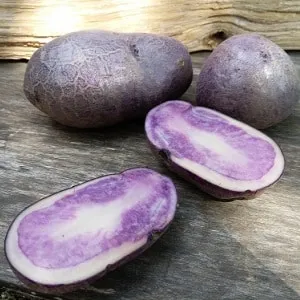 A — 2.9 µg;
A — 2.9 µg;- B1 — 0.14 mg;
- B2 — 0.63 mg;
- B5 — 0.35 mg;
- B6 — 0.34 mg;
- B9 — 0.75 mg;
- C — 21 mg;
- E — 0.11 mg;
- PP — 1.4 mg;
- beta-carotene — 0.02 mg.
Macronutrients:
- calcium — 11 mg;
- magnesium — 22 mg;
- sodium — 4.8 mg;
- potassium — 560 mg;
- phosphorus — 56 mg;
- sulphur — 31 mg;
- chlorine — 46 mg.
Micronutrients:
- iron — 0.91 mg;
- zinc — 0.31 mg;
- iodine — 5.1 µg;
- copper — 136 µg;
- manganese — 0.16 mg;
- fluorine — 27 µg;
- boron — 116 µg;
- aluminium — 850 µg.
Caloric value — 78 kcal.
Nutritional value per 100 g:
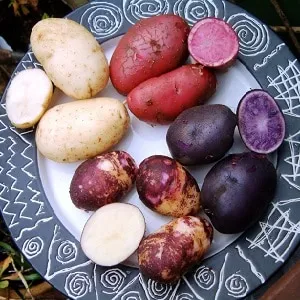 protein — 2.3 g;
protein — 2.3 g;- fat — 0.4 g;
- carbohydrates — 16 g;
- starch — 15 g;
- ash — 1 mg;
- water — 78 g;
- dietary fibre — 1.45 g;
- organic acids — 0.24 g.
Maturation Period
Coloured potatoes have varying maturation periods, as there are early, mid-season, mid-late, and late-maturing varieties.
Yield
Since breeders prioritise quality over quantity, most coloured varieties have moderate yields — 110-320 c/ha. However, some, like the Ukrainian Red Flesh and Purple Beauty, are high-yielding.
Disease Resistance
The main challenge in growing coloured potatoes is their weak immunity. Most varieties have average resistance to late blight, though some, like Exotic, show good resistance to common diseases.
Tuber and Bush Characteristics
The bushes of coloured varieties are medium-height and upright, with large, serrated leaves and medium-sized flowers. Tubers weigh 90-120 g on average and often feature a nutty or ginger-like flavour.
Suitable Growing Regions and Climate Requirements
Coloured potatoes thrive in most European climates, with the best yields in Central, Northern, and Southern Europe. They struggle in regions with short summers.
Pros and Cons
Advantages of coloured varieties:
- classified as a dietary food;
- suitable for diabetics;
- high in antioxidants;
- glycosides slow ageing and inhibit infections;
- anthocyanins may help prevent cancer;
- pleasant taste.
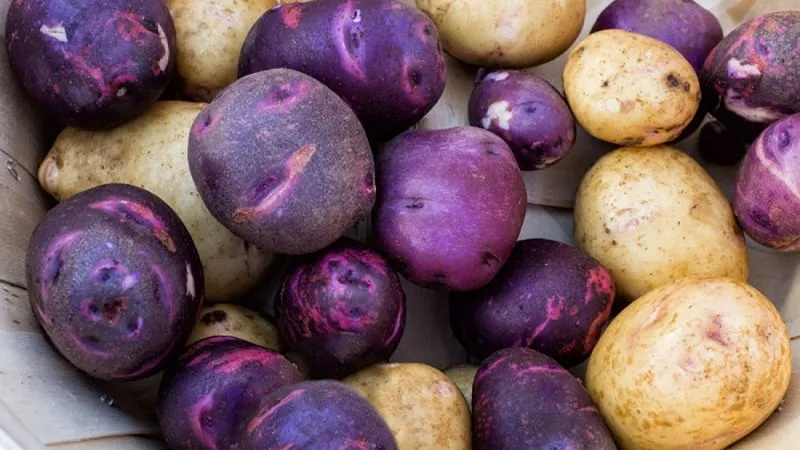
Disadvantages:
- more demanding to grow than traditional potatoes;
- longer maturation period;
- moderate yields;
- lower disease resistance;
- higher price.
Differences from Other Varieties
Coloured potatoes differ from traditional ones in:
- vibrant flesh colours;
- minimal impact on blood sugar levels;
- lower cold tolerance;
- not grown on an industrial scale.
Health Benefits
Coloured potatoes are prized not only for their appearance but also for their health benefits. The carotenoids and anthocyanins they contain act as antioxidants, slowing ageing and potentially reducing infection and cancer risks.
Growing Tips
Coloured potatoes require stricter adherence to cultivation practices. Yield depends on soil quality — it should be fertile and well-aerated. These varieties dislike high temperatures and drought.
Pre-Planting Preparation
Prepare seed tubers 30-40 days before planting. Select healthy, medium-sized tubers with developed eyes and sprout them in boxes. Before sprouting, soak them for 30 minutes in a solution of "Fitosporin" or boric acid (1 g per 10 L of water) to prevent fungal infections.
Important! Due to their moderate disease resistance, disinfecting tubers is essential.
Plant the tubers once sprouts reach 1.5 cm.
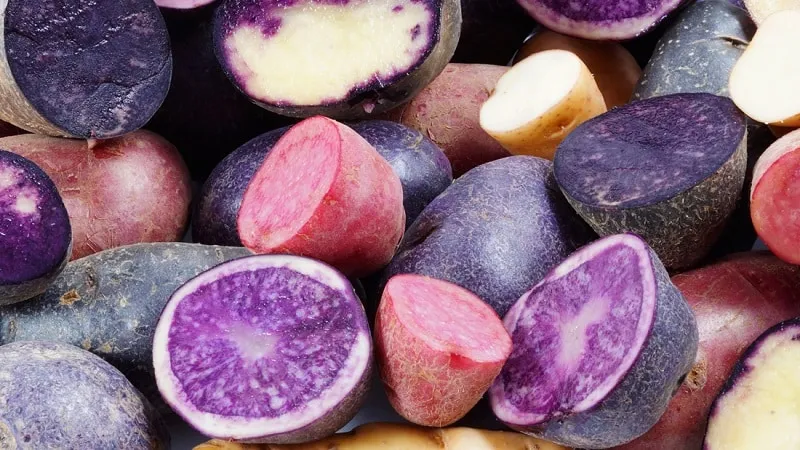
Soil Requirements
Coloured potatoes grow best in light, loamy, sandy-loam, or chernozem soils. Soil sterilisation is crucial.
Planting Time, Scheme, and Rules
Plant sprouted tubers in late May, once the top 10-12 cm of soil warms to +10°C. Timing varies by region.
Choose a sunny spot. In early May, till the soil, adding wood ash and urea.
Space holes 30 cm apart, with 65-70 cm between rows. Place 50 g of compost in each 10 cm-deep hole, then gently add the sprouted tubers. Cover with loose soil. Use frost cloth if temperatures drop.
Care Tips
Soil must be nutrient-rich. In autumn, till deeply, adding 30 g of NPK fertiliser and 0.5 kg of compost per 1 m².
Remove weeds and plant debris.
Plant coloured varieties away from traditional potatoes to prevent cross-pollination.
Some varieties have tall, sprawling foliage and require frequent hilling.
Monitor temperature fluctuations, as extremes reduce yields.
Warning! Late frosts are particularly harmful.
Temperatures below -3°C damage young shoots.
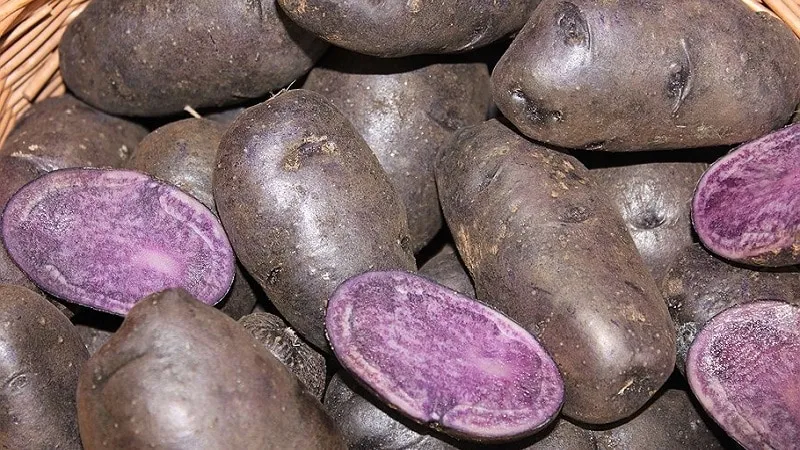
Watering Schedule
Coloured potatoes need more water than traditional varieties. Maintain 70-75% soil moisture.
First watering: when shoots reach 7-8 cm. Use 1.5-2 L of warm water per plant.
Before flowering, water every 7-8 days, adjusting for soil type.
During flowering and tuber formation, increase to 8-10 L per plant every 3 days.
Tip. Drip irrigation prevents soil erosion.
Post-flowering, use 12-15 L per plant.
Final watering: when lower leaves begin to yellow.
Fertilisation
Early growth stage: nitrogen fertilisers (10 g ammonium nitrate and 10 g ammonium sulphate per 10 L water). Alternate with organic matter (50 g compost per 10 L water).
Flowering stage: superphosphate and ammonium nitrate (20 g each per 10 L water).
Post-flowering: boron (5 g boric acid per 10 L water) to improve tuber quality.
Weeding and Hilling
Regularly remove weeds, which compete for nutrients. Loosen soil to aerate roots.
Hill plants to support stems and maintain upright growth.
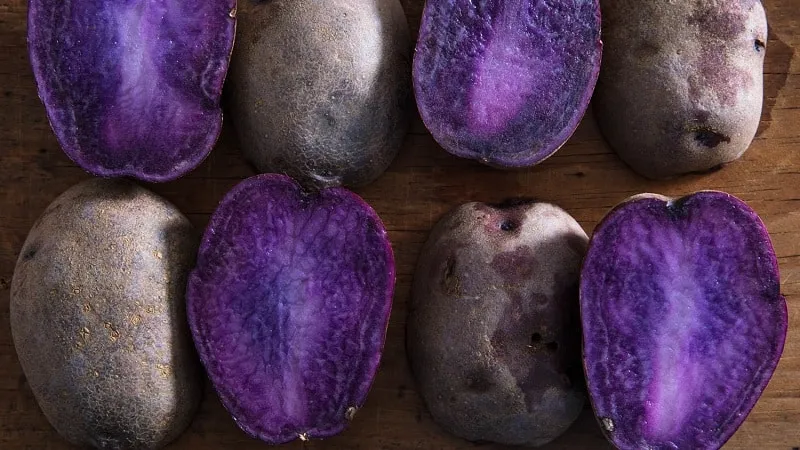
Pest and Disease Control
Coloured potatoes are susceptible to diseases, especially late blight. Dark spots on foliage signal infection, which spreads to tubers.
At first signs, spray with a solution of potassium permanganate, copper sulphate, and boric acid (5 g each per 10 L water). For severe cases, use fungicides like "Teldor" or "Curzate" (15-20 ml per 10 L water).
Fusarium wilt blocks sap flow, yellowing foliage. Treat with "Trichoderma Veride" (50 ml per 10 L water).
Colorado potato beetles can defoliate plants. Use insecticides like "Mospilan" or "Actara" (2 ml per 10 L water).
Wireworms bore into tubers. Plant green manure between rows and treat soil with "Topas" (2 ml per 10 L water).
Growing Challenges
Coloured varieties are frost-sensitive; use row covers if temperatures drop.
Tall varieties may require staking or frequent hilling.
Harvest and Storage
Harvest times vary by variety. Early varieties are ready by early September, late ones by late September.
Harvest in dry weather to avoid damaging tubers.
Dry harvested potatoes in a single layer, sort, and store.
Harvesting Tips
Begin harvesting when foliage yellows. Lift tubers with a fork, shake off soil, and sort. Damaged tubers should be used immediately.
Storage and Shelf Life
Early varieties don’t store well; use them promptly. Late varieties like Vitelotte and All Red store well (95% shelf life) over winter.
Note! Store different-coloured potatoes separately.
Ideal storage conditions: +3…+5°C, 85-90% humidity, and good airflow. Under these conditions, coloured potatoes last 6-8 months.
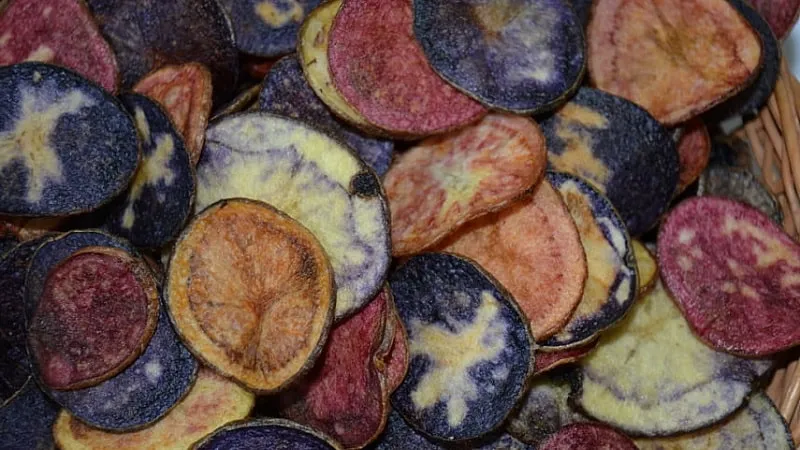
Expert Tips
Experienced growers note that saved tubers produce smaller yields. For best results, buy fresh seed potatoes annually.
Purple varieties have tall, thick stems; space plants 45-50 cm apart.
To preserve colour, boil in salted water for no more than 20 minutes.
Reviews of Coloured Potato Varieties
Feedback on coloured potatoes is mostly positive.
Sophie, France: “I tried the Favourite variety based on its description. It’s delicious — makes the fluffiest mash!”.
Emma, Germany: “I grew Red Wonder and All Blue. The seed potatoes matched the description perfectly. All Blue kept its colour when fried and tasted great.”.
Clara, Spain: “As a diabetic, I appreciate that coloured potatoes don’t spike blood sugar. The white variety with pink eyes was especially tasty.”.
Conclusion
Coloured potatoes are gaining popularity across Europe. Breeders continue to enhance their flavour and disease resistance. Their health benefits and unique appearance make them a favourite among gardeners and chefs alike.







